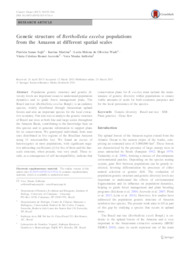Genetic structure of Bertholletia excelsa populations from the Amazon at different spatial scales.
Genetic structure of Bertholletia excelsa populations from the Amazon at different spatial scales.
Autoria: SUJII, P. S.; MARTINS, K.; WADT, L. H. de O.; AZEVEDO, V. C. R.; SOLFERINI, V. N.
Resumo: Population genetic structure and genetic diversity levels are important issues to understand population dynamics and to guide forest management plans. The Brazil nut tree (Bertholletia excelsa Bonpl.) is an endemic species, widely distributed through Amazonian upland forests and also an important species for the local extractive economy. Our aim was to analyze the genetic structure of Brazil nut trees at both fine and large scales throughout the Amazon Basin, contributing to the knowledge base on this species and to generate information to support plans for its conservation. We genotyped individuals from nine sites distributed in five regions of the Brazilian Amazon using 11 microsatellite loci. We found an excess of heterozygotes in most populations, with significant negative inbreeding coefficients (f) for five of them and the finescale structure, when present, was very small. These results, as a consequence of self-incompatibility, indicate that conservation plans for B. excelsa must include the maintenance of genetic diversity within populations to ensure viable amounts of seeds for both economic purposes and for the local persistence of the species.
Ano de publicação: 2015
Tipo de publicação: Artigo de periódico
Palavras-chave: Bertholletia Excelsa, Brazil nut tree, Brazil nuts, Castanha do pará, Castanha-do-brasil, Dinámica poblacional, Dinâmica populacional, Diversidade genética, Essência florestal, Estrutura genética, Fitomejoramiento, Genetic diversity, Genetic markers, Genetic variation, Madera tropical, Manejo florestal, Marcador genético, Marcador microssatélite, Marcadores genéticos, Melhoramento genético vegetal, Microsatellite repeats, Nuez del Brasil, Plant breeding, Population dynamics, Repeticiones de microsatélite, SSR, Tropical wood, Variación genética, Variação genética, gene flow, plant genetics
Observações
1 - Por padrão são exibidas publicações dos últimos 20 anos. Para encontrar publicações mais antigas, configure o filtro ano de publicação, colocando o ano a partir do qual você deseja encontrar publicações. O filtro está na coluna da esquerda na busca acima.
2 - Para ler algumas publicações da Embrapa (apenas as que estão em formato ePub), é necessário ter, no celular ou computador, um desses softwares gratuitos. Sistemas Android: Google Play Livros; IOS: iBooks; Windows e Linux: software Calibre.
Acesse outras publicações
Acesse a Base de Dados da Pesquisa Agropecuária (BDPA) para consultar o acervo completo das bibliotecas da Embrapa.

